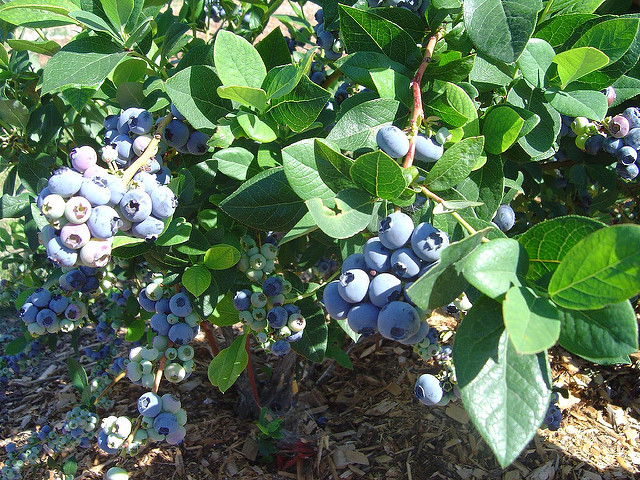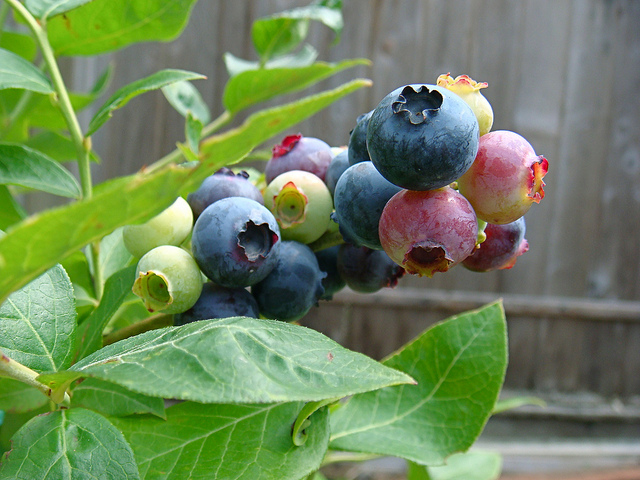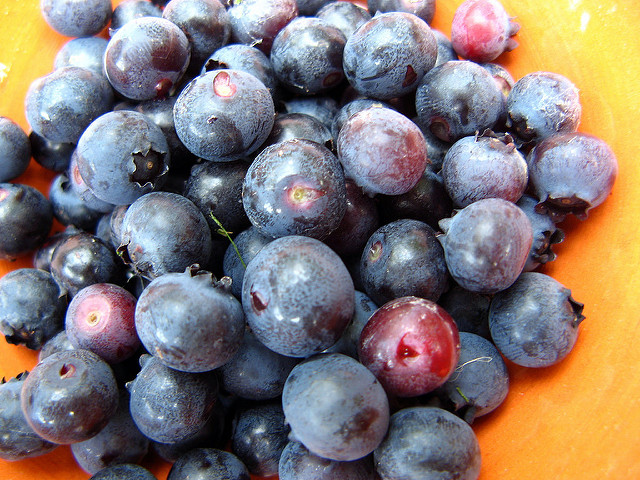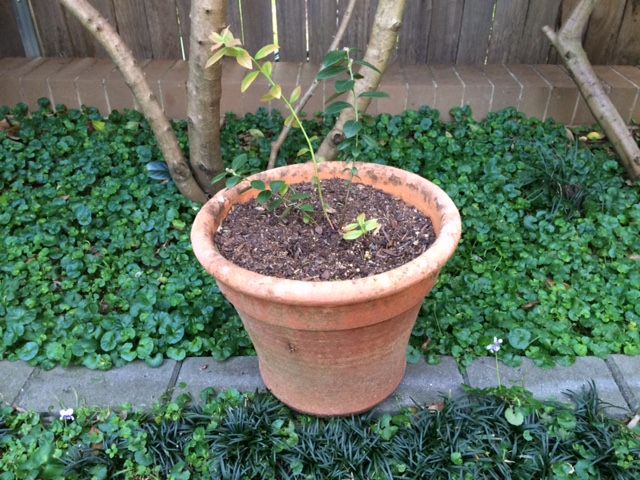Unless you are lucky enough to be able to regularly pick your own berries from a local farm, blue berries are one of those fruit that usually come with along with the guilt of plastic packing.
When I heard that some people believe blueberries can be easier to grow in a pot than in the ground I immediately decided to give them a go! I've been hard at work researching so that I can give my plants the best chance.
Description
A medium to tall thornless shrub varying in size from 1 to 4 metres. Plants can be evergreen, partially evergreen, or full deciduous depending on the variety and growing conditions.

image: Duncan Mackenzie (Flickr)
Grow in acidic soil
Blueberries are related to rhododendrons, camellias and azaleas and therefore require acidic soil with a pH of around 4.5 to 5.5. Most backyards have higher pH than this and you will need to adjust the pH well before planting. Pop into your local nursery for assistance. If you are planting your blueberry in a pot you can simply buy a potting mix for camelias and azaleas.
Select the correct variety for your region
Most blueberries are grown in Southern Highlands of NSW however by selecting the correct variety you can grow them in most areas of Australia. The descriptions of varieties will usually mention the number of "chilling hours" needed and this refers the number of hours below 7 degrees celcius needed to produce fruit. For Blueberries this is generally between 250 and 1000 hours. One variety called 'Blueberry Burst' is advertised can be grown in most areas of Australia.
Plant almost any time
You can plant your blueberries any time, although it is best to avoid the heat of summer. Place your plants at 1.5 to 2 metre intervals. You will find plants available bare-rooted as well as in pots.

image: Juliana Su (Flickr)
Grow your blueberries in a pot or in the ground
Blueberries can successfully be grown in a medium to large pot or half wine barrel. Remember to fill the pot with azalea and camellia potting mix which has a higher acidity.
Choose a sunny and protected position
A sunny position is best for flowering and fruit production. Protection from winds is also important. If your plants are in pots you may need to provide some protection from the heat of the sun in summer.
Keep the soil moisture fairly constant
Blueberries have fine roots but have few root hairs making them more sensitive to fluctuating soil-water conditions. Drip irrigation is one way of keeping plants happy and mulching in another.
Provide friends
Although blueberries can self-pollinate, fruiting is often enhanced by planting compatible cross-pollinating varieties. These varieties are usually listed in the description of the blueberry if it is beneficial.

image: Dave Gunn (Flickr)
Be patient when harvesting
The first harvest can be achieved after 1- 3 years but it takes several seasons before plants reach their full potential. Berries turn blue 3-4 days before they attain their maximum flavour but not all berries in the cluster will necessarily ripen at the same time. Try and be patient. They can be stored in the refrigerator for around a week and can also be frozen.
Prune during the winter or early spring
For the first 12 to 18 months the focus should be on getting plants established and simply pruning off flowers, dead wood and weak growth. Pruning can be done at any time but is best towards the end of the dormant season in late winter and early spring. To maximize light and air-flow prune to keep the center of the plant open. Canes are most productive when they are 3-6 years old.
Grow more berries through propagation
It's relatively easy to propagate plants from hardwood cuttings taken during winter, and from soft-tip cuttings taken during summer.
Keep an eye out for pests and diseases
Generally blueberries tend to have few problems with pests and diseases. Netting can prevent birds from eating crops and by pulling out plants such as dandelions you can prevent a virus that can be transmitted by nematodes in the soil.
Don't panic if your blueberries aren't producing fruit
This could be due to a number of factors:
- inadequate sunlight to initiate enough flowering
- temperatures being so freezing that the fruit don't develop
- the pH not being optimal
- needing another plant for better pollination

image: Anna Gregory
Here's a picture of the blueberry I just planted. It's now started to develop flowers and I know I should pull them off but I'll leave them a little bit longer. Finding some bigger pots is my next goal and I'm looking at varieties such as 'Misty', 'Legacy' and 'Blueberry Burst' as companions for this plant. These varieties are all suitable for Sydney.
Have you successfully grown blueberries? Share your experiences below.
banner image: @rsseattle (Flickr)
Try this next: Mouthwatering blueberry and buckwheat pancakes

